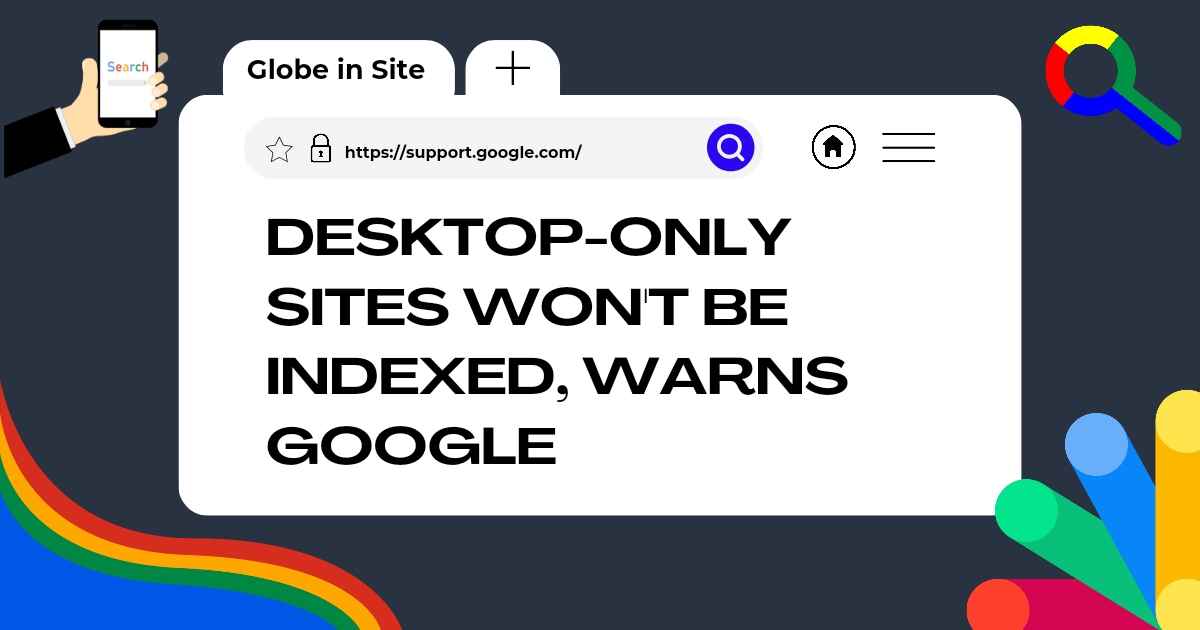Google’s most recent declaration: Desktop-only sites will not be indexed. Realize the reason why mobile-first indexing is critical and how to enhance your site.
Presentation
Google has as of late reported a tremendous change in its indexing strategies, sending shockwaves through the web improvement and SEO people group. The search monster has made it understood: desktop-only sites will never again be indexed. This implies in the event that your website isn’t mobile-accommodating, it should be imperceptible on Google search. Be that as it may, why is Google taking this action? Also, what’s the significance here for website proprietors?
Grasping Mobile-First Indexing
Definition and Idea
Mobile-first indexing construes that Google transcendently incorporates the mobile version of the substance for indexing and arranging. Overall, the desktop version of a page’s substance was viewed as the essential version, right now this isn’t right any more.
History of Mobile-First Indexing
Google first reported the mobile-first indexing drive in November 2016. The change was driven by the developing number of mobile clients and the need to further develop client experience across gadgets. All through the long haul, Google has been continuously moving to this philosophy, and the new announcement indicates the last advance toward this change.
The Shift from Desktop-Only to Mobile-First
Purposes behind the Shift
The main purpose for this shift is basic: client conduct. More individuals are getting to the web through mobile gadgets than at any other time. Google aims to guarantee that clients find content that is improved for their gadgets, upgrading their perusing experience.
Advantages of Mobile-First Indexing
Further developed Client Experience: Mobile-accommodating sites load quicker and give a superior overall encounter.
Higher Engagement: Clients are bound to remain on and interact with a site that is streamlined for mobile.
Better Rankings: Mobile-upgraded sites are leaned toward in search rankings, driving more natural traffic.
Effect of Google’s Declaration on Desktop-Only Sites
Quick Impacts
For desktop-only sites, the quick impact is unmistakable: they won’t be indexed. This implies these sites will not show up in Google search results, prompting a critical drop in rush hour gridlock.
Long haul Ramifications
Over the long haul, sites that don’t adjust to mobile-first indexing will battle to maintain their web-based presence. This could bring about lost income and diminished brand perceivability, making it urgent for organizations to quickly adjust.
Technical Parts of Mobile-First Indexing
How Mobile-First Indexing Functions
Googlebot essentially crawls and indexes the mobile version of websites. In the event that a site has different substance on its desktop and mobile versions, the mobile substance will be considered for indexing and positioning.
Technical Necessities for Mobile-First Indexing
To be indexed under mobile-first indexing, a site must:
- Guarantee that mobile and desktop versions have a similar substance.
- Utilize responsive website composition or dynamic serving.
- Enhance images and recordings for mobile.
Adjusting to Mobile-First Indexing
Moves toward Progress from Desktop-Only to Mobile-Accommodating
Review Your Ongoing Site: Distinguish regions where your site needs mobile optimization.
Execute Responsive Plan: Guarantee your site changes seamlessly to various screen sizes.
Test Your Site: Use devices like Google’s Mobile-Accommodating Test to really look at your advancement.
Normal Difficulties and How to Defeat Them
Content Disparity: Guarantee all satisfied available on the desktop site is additionally open on the mobile version.
Technical Issues: Address stacking times, media optimization, and other technical factors that could influence execution.
Best Practices for Mobile Optimization
Responsive Website architecture
Responsive website architecture guarantees your site looks great on all gadgets. This includes adaptable designs, images, and CSS media inquiries.
Accelerated Mobile Pages (AMP)
AMP is an open-source system that makes quick stacking mobile pages. Executing AMP can fundamentally help your site’s mobile presentation.
Streamlining Images and Media
Pack images and use designs like WebP for quicker load times. Additionally, guarantee that recordings are appropriately scaled and upgraded for mobile review.
SEO Methodologies for Mobile-First Indexing
Mobile SEO Techniques
Utilize Short, Engaging URLs: These are simpler to peruse and share on mobile gadgets.
Improve Titles and Meta Description: Ensure these are brief and applicable to mobile clients.
Local SEO: Improve for neighborhood search, as numerous mobile searches are area based.
Content Optimization for Mobile
Compact and Clear: Mobile clients lean toward more limited, more straightforward substance.
Clarity: Utilize bigger text styles and stay away from thick sections.
Speed Optimization
Limit HTTP Solicitations: Decrease the quantity of components on your page.
Leverage Program Storing: This helps accelerate rehash visits.
Utilize a Substance Conveyance Organization: Disperse your substance nearer to your clients to decrease load times.
Apparatuses and Assets
Google’s Mobile-Friendly Test
This apparatus assists you with rapidly deciding whether your site is mobile-accommodating and gives ideas to progress.
Other Helpful Instruments
PageSpeed insights: Offers detailed investigation on the most proficient method to work on your site’s speed.
Search console: Screen your site’s presentation and investigate issues.
Screaming Frog: Review your site for SEO issues, including mobile optimization issues.
Conclusion
The shift to mobile-first indexing by Google is a critical achievement in the development of web improvement and SEO. Desktop-only sites should adjust rapidly or risk becoming outdated. By figuring out the significance of mobile-first indexing, carrying out accepted procedures, and remaining updated with patterns, organizations can guarantee they remain noticeable and cutthroat in the steadily changing digital landscape.
FAQs
What is mobile-first indexing?
Mobile-first indexing implies that Google prevalently involves the mobile version of the substance for indexing and positioning.
Why is Google focusing in on mobile-first indexing?
Google is focusing in on mobile-first indexing considering the way that most clients at present access the web through mobile contraptions, and this approach ensures a predominant client experience.
How should I check if my site is mobile-obliging?
You can use Google’s Mobile-Obliging Test mechanical assembly to check if your site is smoothed out for mobile contraptions.
What occurs on the off chance that my site remains desktop-only?
In the event that your site remains desktop-only, it won’t be indexed by Google, meaning it will not show up in search results and will probably encounter a huge drop in rush hour gridlock.
Are there any special cases for Google’s mobile-first indexing?
At this point, there are no exemptions. All sites should be mobile-accommodating to be indexed by Google.

